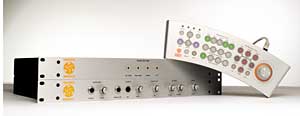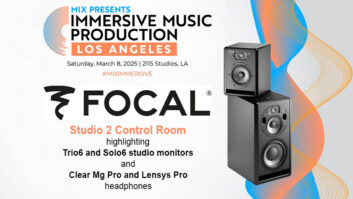
Not quite as dangerous as it sounds, but certainly exciting, Dangerous Music’s Monitor ST and Monitor SR are highly useful companions in today’s ever-evolving studio monitoring setups. Flexible routing and monitoring are more critical than ever, with many users now working both “inside” and “outside-the-box.” Toggling from stereo (with and without subs) to 5.1 for comparative analysis can be a headache, but the Monitor ST and SR resolve these issues with versatility and lots of features.
STEREO STALWART
The stereo Monitor ST ($2,199) contains the main system, including the computer-based remote controller, front panel controls and rear panel access for power supply, controller cable interface, cue and talkback feeds, and multipin DB-25 connectors for inputs and outputs.
Users who work without a traditional console master-output section will welcome the ST’s front panel controls: adjustable-level headphone jack, talkback mic, level control and external input jack. The built-in mic is all that’s needed for most studio settings, while the external input comes in handy if the unit is placed at a distance from the main monitoring area. A “Main to Cue Level” control routes any selected source to the cue amp output.
Two other inputs are controlled via the front panel. The aux input-level control routes signal to main or cue, and can be enabled via the remote control for any number of scenarios in which this signal needs to be monitored — click tracks, computer audio, etc. An input 4 level pot quickly became a favorite: In many cases, my CD player’s output was routed to this input, allowing me to instantly toggle to reference CDs to compare works in progress.
Rear panel connections include two XLR aux inputs, a pair of DB-25 I/O connectors, power supply DIN jacks, talkback remote jack, slate output, cue amp out and a port for connecting to the remote controller.
THE SURROUND MODULE
As an add-on, the SR surround module ($1,499) has a straightforward layout. The rear panel connectors are four sets of DB-25 I/O ports, power supply connections and routing for the remote controller. (The ST module functions alone or with the SR module.)
The first two speaker outputs are for two separate 5.1 surround systems and are configured identically, while output 3 has a stereo feed for the front channels and a combined (mono) feed for a sub, along with two other separate sub outs (LFE left and LFE right) for systems with multiple subs. Output 4 is for metering of any selected input source. On the SR’s front panel are four recessed trim pots for adjusting left-rear, right-rear, center and LFE speaker feeds.
ALWAYS IN CONTROL
The real fun begins with the Dangerous Remote, a wedge-shaped, easy-to-read, multicolored, lighted remote controller. Fed by a Cat-5e cable, the remote can be placed anywhere; there are really no limits to the length of the cable run. After spending a few minutes consulting the occasionally confusing manual, it was easy to get up and running, and understand the various functions of the computer’s memory storage and how the color-coded controls work. The blue buttons are for programming and updating system gain and configurations. The green buttons select inputs, speakers and subwoofer routing. The orange buttons handle mono and aux to main, talkback and dim functions. The red buttons provide easy mute/solo toggling in various listening modes.
Regardless of skill level and experience in setting up a room, the recessed speaker-feed adjustments make for easy 5.1 alignment. My setup involved a pink-noise source and a Radio Shack SPL meter (model #3-2055). I followed the manual’s suggestion of starting at 80 dB at the listening position and then I worked my way around the system, using the flat “C” mode weighting on the SPL meter. Going further with higher (and much lower) listening level tests, as well as several of my own stereo and surround projects, I quickly settled into a comfortable and finely balanced setting.
The system’s quiet, smooth operation is one of its most enjoyable aspects. It uses no VCAs or DCAs in its output circuitry, and the sound quality is rock-solid and consistent at all listening levels. It’s a comfort to hear the internal, inert gas — filled, gold-contact relays quietly clicking along as the absolute-value stepped attenuator moves from each position to the next. In both balanced and unbalanced operation, the ST/SR combination was transparent and smooth in operation.
EASY-LISTENING STREET
A few minor quibbles about the owner’s manual aside, once you’re dialed in and running, this is one smart and effortless controller that you’ll want to play with while you work. After grasping the factory-default settings, I easily “rolled my own” to create setups and routings. In a very brief time, I was quickly working with easily repeatable results, changing monitoring environments as needed. Once you get comfortable with it, you’ll wonder how you got along without one.
Dangerous Music, 607/965-8011, www.dangerousmusic.com.
Joe Hannigan runs Weston Sound & Video in Philadelphia.







